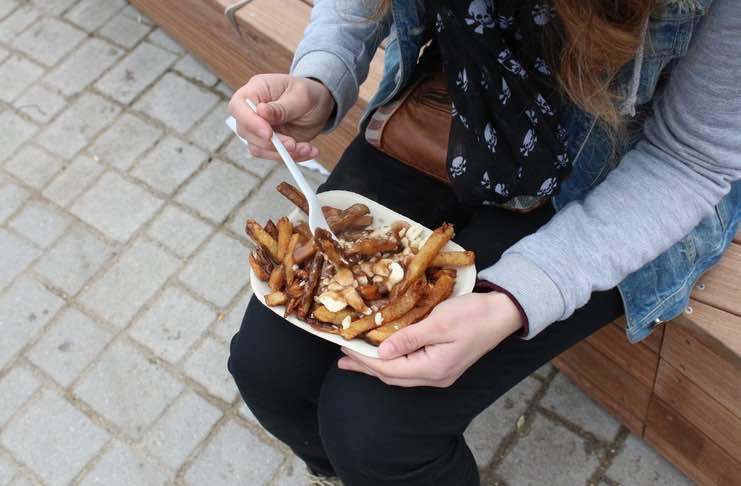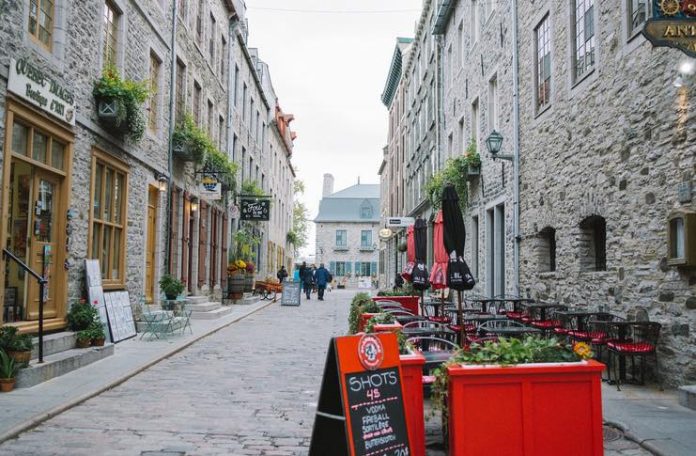Embarking on a culinary odyssey through French Canada transports you into a fairytale adorned with irresistible flavors and time-honored customs. In enchanting locales like Quebec City’s Old Town, Montreal’s vibrant neighborhoods, and the picturesque villages of Charlevoix, the French heritage intertwines seamlessly with Canada’s rugged beauty, creating a culinary tapestry that delights the senses.
Wandering along charming cobblestone streets and exploring lively markets reveals a treasure trove of gastronomic delights and the tales of those who skillfully prepare them. Whether savoring the comforting warmth of fresh poutine on a crisp winter day or indulging in the intricate layers of a classic tourtière, each dish serves as a testament to the region’s cultural richness. Together, we unravel the mysteries behind these delectable creations, honoring the fusion of history, natural abundance, and culinary artistry that defines French Canadian cuisine.
Understanding French Canadian Cuisine
This cuisine is rich with history, a blend of Indigenous traditions, French culinary practices, and influences from Irish and British settlers. The melting pot of flavors has given rise to unique dishes that tell the stories of survival, adaptation, and community.
Regional Specialties and Their Cultural Significance
Across the vast landscapes of French Canada, regional specialties emerge as distinctive markers of a rich cultural identity.
In Quebec,

—a dish of fries, cheese curds, and gravy—stands out as a beloved comfort food with humble origins, now celebrated at festivals and gourmet restaurants alike.
Meanwhile, the Acadian dish of rappie pie tells of resilience and resourcefulness, a hearty meal born from the necessity to feed large families.
Watch this video to get a glimpse of this delicious pie:
Each region’s signature dishes not only delight the palate but also embody the local history, climate, and community spirit.
The Role of Seasonal Ingredients in French Canadian Dishes
Seasonality plays a pivotal role in the culinary calendar of French Canada, where the changing seasons dictate the flavors on the table.
Spring brings the much-anticipated maple syrup season, marking a time of renewal and celebration. Summer offers an abundance of fresh produce, from berries to vegetables, that find their way into salads, jams, and traditional dishes like the strawberry shortcake. Fall is synonymous with harvest, a period to indulge in apple-based desserts and hearty meals prepared with root vegetables. Winter, with its cold embrace, is a time for comfort foods like tourtière and rich, meaty stews that warm the heart and soul.
This deep connection to the rhythm of the seasons not only influences what is eaten but also reinforces the bond between the people and their environment, a core aspect of French Canadian culinary tradition.
Planning Your Culinary Journey
Whether you’re drawn by the allure of seasonal delicacies, the charm of regional festivals, or the warmth of rustic, farm-to-table meals, mapping out your visit based on the culinary calendar and key destinations can transform a simple trip into an unforgettable gastronomic adventure.
Best Times of Year to Visit French Canada for Culinary Travelers
For a sweet start, visit during March and April to catch the maple syrup season, where sugar shacks offer a taste of tradition with their maple-infused treats.
Watch this video to learn more about maple syrup season in Canada:
Summer brings vibrant markets and food festivals, making June through August ideal for sampling fresh local produce and gourmet delights.
Harvest season in September and October is perfect for experiencing hearty comfort foods and fresh wines.
Winter, especially from December to February, offers cozy dining and festive treats against a snowy backdrop, with Quebec’s Winter Carnival being a seasonal highlight.
Key Regions in French Canada for Culinary Exploration
- Quebec City: Step into a living museum, where traditional dishes and modern culinary innovation meet. The city’s food tours are a great way to explore its culinary history.
- Montreal: Known for its vibrant food scene, Montreal offers a blend of traditional French Canadian dishes and international cuisine, with endless dining options from street food to haute cuisine.
- Rural Quebec: Venture into the countryside to experience the farm-to-table movement, where local ingredients shine in simple, yet exquisite, dishes. Visits to local farms and artisanal producers can offer a deeper understanding of the region’s culinary roots.
Watch this video to learn more:
Choosing Accommodations that Enhance the Culinary Experience
Selecting accommodations that prioritize local flavors and culinary experiences can greatly enrich your journey. From boutique hotels offering gourmet dining to cozy B&Bs with family-style meals, where you stay can provide unique insights into French Canadian cuisine and even opportunities for practicing with native speakers in a more intimate, culinary-focused setting.
Immersive Culinary Experiences
Diving into French Canadian cuisine is about more than just eating; it’s about engaging with the culture, history, and people who make this culinary scene so vibrant.
Cooking Classes with Local Chefs
Cooking classes with local chefs are a gateway to the heart of French Canadian cuisine, offering a unique blend of cultural immersion and culinary education. These classes often include a market visit, where the act of selecting ingredients becomes a lesson in local foodways and an opportunity for practicing with native speakers, enriching your culinary skills and language proficiency simultaneously.
Guided Food Tours
Guided food tours offer a curated taste of French Canada’s culinary wonders, providing insight into local favorites, hidden eateries, and the historical context behind each dish. These tours are an excellent way to navigate the culinary landscape, especially for first-time visitors keen on discovering the essence of French Canadian food culture.
Check out this food and drink tour in Montreal:
Visiting Local Markets and Farms
Local markets and farms are the lifeblood of French Canadian cuisine, connecting the dots between land, tradition, and table. These visits not only reveal the importance of fresh, seasonal ingredients but also foster a connection with the community and its agricultural roots, offering a taste of the real French Canada beyond the restaurant scene.
Special Events and Festivals
Throughout the year, French Canada buzzes with food festivals and culinary events that celebrate the region’s diverse gastronomy. These gatherings are not just about savoring delicious food but also about coming together to share in the joy of cooking, eating, and learning about the cultural significance of each dish.
Dining Like a Local
To truly immerse yourself in the culinary heart of French Canada, dining like a local is key. This means venturing beyond the tourist hotspots to where authentic flavors and traditions thrive. It’s about seeking out those hidden gems that offer a genuine taste of the region, from family-run bistros to neighborhood bakeries.
Tips for Finding Authentic French Canadian Restaurants and Eateries
Navigating the vast culinary landscape of French Canada might seem daunting, but with a few insider tips, you can easily find those spots cherished by locals.
Look for restaurants that source their ingredients locally, indicating a commitment to regional flavors and quality. Don’t be afraid to ask residents for their personal recommendations, as this can lead you to some of the best dining experiences. Additionally, exploring on foot can uncover hidden culinary treasures that aren’t always listed in travel guides.
Must-Try Dishes and Where to Find Them
French Canadian cuisine is renowned for its distinctive dishes, each with its own history and flavor profile.
Poutine, with its crispy fries, squeaky cheese curds, and rich gravy, is a must-try, best enjoyed at small diners or food trucks where it’s made with love and tradition.
Tourtière, a savory meat pie, offers a taste of the holidays year-round, found in bakeries and family kitchens across Quebec.
For a sweet treat, tarte au sucre (sugar pie) provides a decadent glimpse into the region’s love affair with maple syrup.
Adding to this delectable lineup, smoked meat sandwiches, particularly Montreal-style smoked meat, are a cornerstone of the region’s culinary offerings. Thinly sliced and piled high on rye bread with mustard, these sandwiches are a staple in Montreal delis and offer a taste of the city’s Jewish deli tradition.
Lastly, pea soup, known as soupe aux pois, is a comforting, hearty dish that showcases the simple yet rich flavors of French Canadian cuisine. Made with dried peas and often ham or pork, it’s a warming dish found in diners and homes, especially during the colder months,
Get Ready for a Culinary Adventure!
Exploring French Canada through its culinary traditions is a journey that feeds more than just the appetite—it nourishes the soul. As you traverse this rich landscape, remember that every dish, every flavor, and every tradition you encounter is a story waiting to be discovered. Embrace each taste and moment with an open heart and curious palate.
Your culinary adventure in French Canada is not just about the food you’ll eat but the memories you’ll savor long after the journey ends.










 Sarah Knapp is a Brooklyn based entrepreneur whose love for the outdoors and community building led her to the October 2013 creation of OutdoorFest. She has a BA in History, is a Wilderness First Responder and a NY state hiking, camp and boating guide. Her proudest achievement to date is reading the Aeneid in Latin.
Sarah Knapp is a Brooklyn based entrepreneur whose love for the outdoors and community building led her to the October 2013 creation of OutdoorFest. She has a BA in History, is a Wilderness First Responder and a NY state hiking, camp and boating guide. Her proudest achievement to date is reading the Aeneid in Latin.  Allison was one of our first top writers and Chief Editor but is no longer working with offMetro. Allison is a native New Yorker, who has lived in Rome, Tuscany, Melbourne, Toronto and Los Angeles. She frequently contributed travel pieces to Family Travel Forum, using her own children as guinea pigs as they travel the globe. She never missed a chance to sample local delicacies, as her love for travel goes hand-in-hand with her love for food and wine.
Allison was one of our first top writers and Chief Editor but is no longer working with offMetro. Allison is a native New Yorker, who has lived in Rome, Tuscany, Melbourne, Toronto and Los Angeles. She frequently contributed travel pieces to Family Travel Forum, using her own children as guinea pigs as they travel the globe. She never missed a chance to sample local delicacies, as her love for travel goes hand-in-hand with her love for food and wine.  Josh Laskin is a freelance travel writer and photographer based in the White Mountains of New Hampshire. When he is not at work or on the road, you can find him in the mountains snowboarding, climbing, hiking, fly fishing, mountain biking, and eating bagel bites.
Josh Laskin is a freelance travel writer and photographer based in the White Mountains of New Hampshire. When he is not at work or on the road, you can find him in the mountains snowboarding, climbing, hiking, fly fishing, mountain biking, and eating bagel bites. Annie is a travel writer, environmentalist, and surfer based in Venice, CA. She heads up our West Coast team, keeps our grammatical errors in check, and makes sure our California writers always have a plan for their next adventure. Follow Annie’s travels @annelisemcb.
Annie is a travel writer, environmentalist, and surfer based in Venice, CA. She heads up our West Coast team, keeps our grammatical errors in check, and makes sure our California writers always have a plan for their next adventure. Follow Annie’s travels @annelisemcb. Carly Pifer is a freelance writer who has been known to follow whims inspired by romantic movie scenes or colorful street style shots to India, Japan, Tunisia and Argentina. After stints living in Seoul, Boston, Paris and Los Angeles, writing and searching for something intangible, she landed somewhat steadily in Brooklyn and has begun to find inspiration in her more immediate surroundings.
Carly Pifer is a freelance writer who has been known to follow whims inspired by romantic movie scenes or colorful street style shots to India, Japan, Tunisia and Argentina. After stints living in Seoul, Boston, Paris and Los Angeles, writing and searching for something intangible, she landed somewhat steadily in Brooklyn and has begun to find inspiration in her more immediate surroundings.  Kate E. O’Hara is a New York based freelance writer and photographer who loves all things food—especially the people who make it and market it. Her writing aims to capture the essence of the food experience; the stories that go well beyond a plate of ingredients. In addition to her love of food, Kate is also known to have a hankering for red wine and craft beer. You can also find Kate on Instagram
Kate E. O’Hara is a New York based freelance writer and photographer who loves all things food—especially the people who make it and market it. Her writing aims to capture the essence of the food experience; the stories that go well beyond a plate of ingredients. In addition to her love of food, Kate is also known to have a hankering for red wine and craft beer. You can also find Kate on Instagram